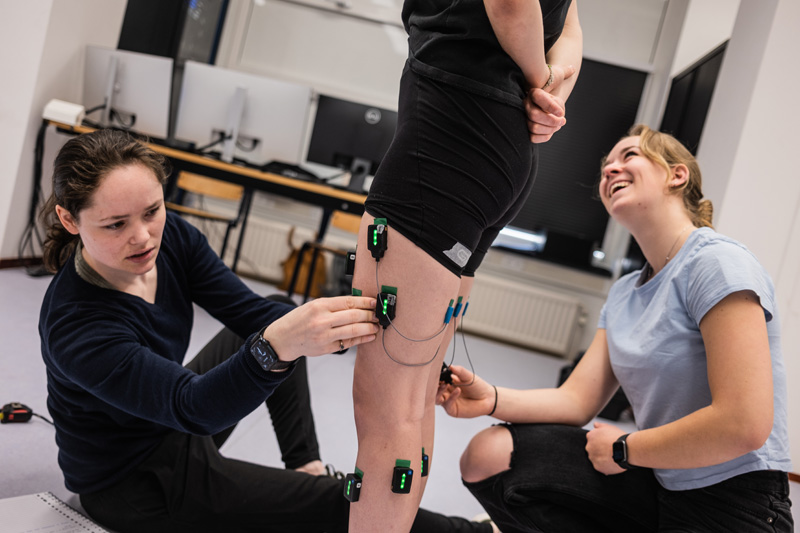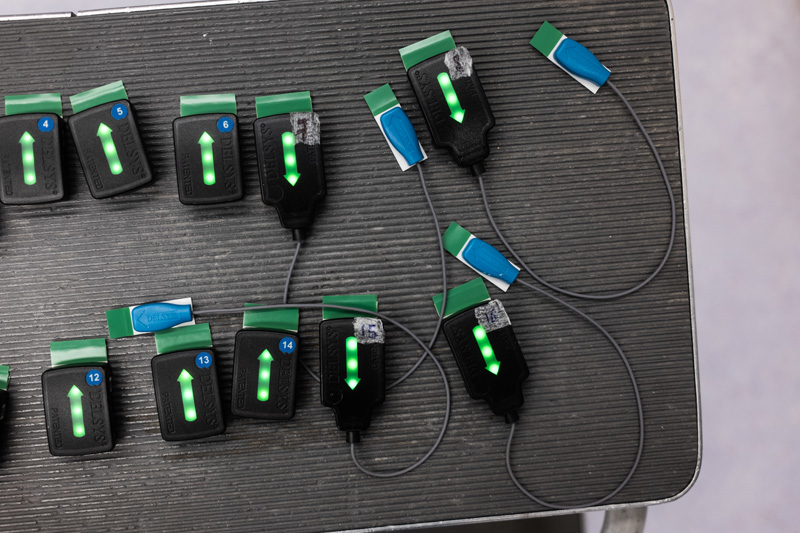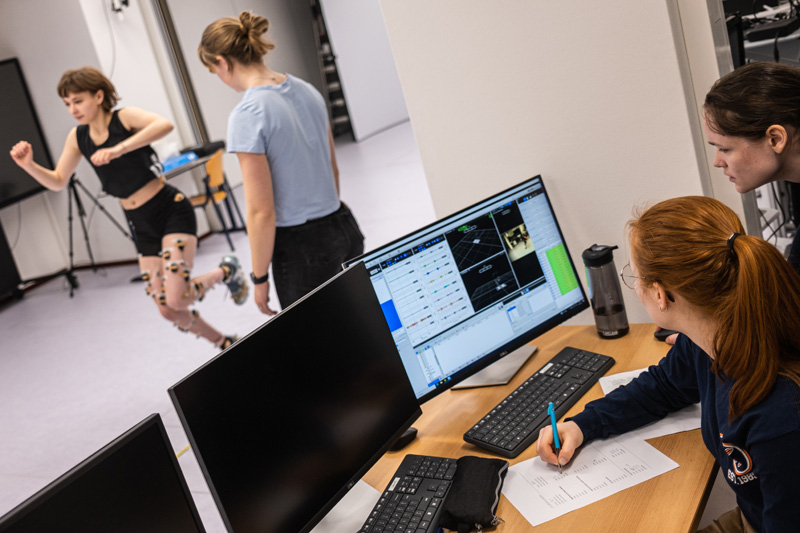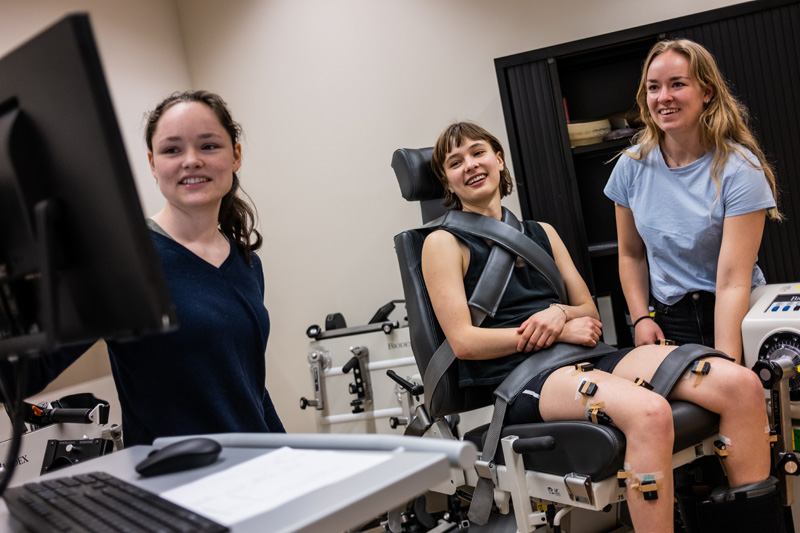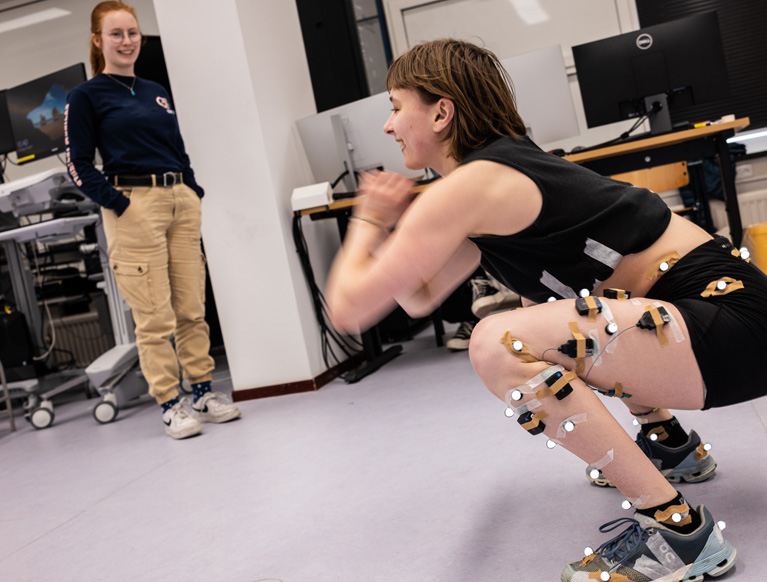
Guinea pigs #7Muscle fatigue and knee movement
‘I’m cheered on while I do single-leg hops’
I know so many people with knee injuries, I realised when I received the invitation to participate in this study. Immediately, at least five people my age came to mind who I know have been struggling with them. And from what I’ve heard, the road to recovery is tough, often marked by prolonged immobility or re-injury.
Reducing knee movement is essential after anterior cruciate ligament (ACL) reconstruction, as excessive mobility increases the risk of re-injury. But the current assessments used to determine whether someone who has undergone surgery is ready to return to sports are far from perfect.
Also known as the ‘return to sports battery’, these tests often clear patients who aren’t fully capable of resuming sports activities yet, explains Michèle Keizer, principal researcher on this study and a lecturer at the department of human movement sciences.
Four study groups
Commissioned by the UMCG, Martini Hospital, and the Orthopedisch Centrum Oost Nederland, her study investigates various aspects that have the potential to improve treatment following ACL surgery, as well as the return to sports battery.
The study’s participants are divided into four distinct groups of twenty. The group I’m participating in focuses on the impact of muscle fatigue on the movement inside the knee. If that impact proves significant, Keizer suggests that this should be incorporated into the existing test battery. Other groups explore aspects such as the effect of multitasking on knee movement.
To participate in the study, one must be between 18 and 45, in good health, with no history of surgery, and devoid of any ankle, knee, or hip problems. Fortunately, I meet all requirements. So on a sunny Tuesday morning, I make my way to the UMCG for what I feel will be quite an active three-hour endeavour – it was emphasised that I come prepared, bringing a pair of tight shorts and sports shoes.
Measurements
As I arrive, I’m welcomed by Keizer, as well as Vivian den Hertog (21) and Senja Prince (22), third-year bachelor students of human movement sciences. They ask me to complete a questionnaire, providing basic information about myself such as my age (23), my gender (woman), or my sports activities (bouldering and a home workout here and there).
Once I’m done, I change into my athletic clothes, and Vivian proceeds to measure my height and weight. Then, I lie face up on an examination table and Vivian attaches a device called a ‘rolimeter’ to my lower leg. It’s commonly used in the examination of people with ACL problems to assess knee mobility. ‘Essentially, it measures the passive translation in the knee joint of the lower leg regarding the upper leg’, explains Keizer.
To be able to study the effect of the excersises I’ll be doing, the women also stick a multitude of markers and electrodes on my legs.
Forty-two small, reflective markers now adorn my lower body like ornaments on a Christmas tree. They will reflect the infrared light of the sixteen cameras that are set up across the room, enabling the computer to generate a live image of my leg movement. Sixteen rectangular electrodes, known as electromyography (EMG) markers, are glued to the muscles of my belly to record their electrical activity.
3D camera system
Before we start the actual experiment, I have to perform a series of jumps to assess how far I can jump. Next, the 3D camera system requires calibration. For that, I first assume a position as if I’m sitting on a motorcycle, so the system can label the different markers and recognise them later. Then I make circles with a straight leg, the other one standing, so the system can determine the centre of my hips. Lastly, I bend and stretch my legs a few times, determining the rotation axis of my knees.
As Senja sits down behind the computer, Vivian instructs me on what will happen next: I have to perform various jumps, first in a normal state, and later in a fatigued state. And after a thorough preparation, the actual experiment commences: I do side-hops, jumping to the left with my left leg and to the right with my right leg. Next, I do jump landings, where I leap down from a stool only to immediately jump back up.
I do single-leg hops, challenging my balance as my feet have to remain firmly still upon landing. Finally, I walk across the room: embedded within the floor at the room’s centre are force plates, measuring the ground reaction force exerted on my body with each stride.
Squat jumps
So far, so good. But now I have to repeat all the tasks in the exact same order, yet this time I do thirty seconds of squat jumps before each of them. Encouraging cheers from the girls help me hold up quite well during the first three rounds, to my surprise. Only the last round pushes me to my limits, but I manage to complete the task as well.
After that, I do a test in a measuring chair called the BioDex. The researchers firmly anchor me to the chair, like when you fasten your seat belts in the car. Here, I have to stretch and bend my legs as vigorously as possible. ‘This allows us to measure the force you can make with your leg, or the maximum isometric contractions of muscles’, Keizer clarifies.
It was pretty intensive, this experiment. But for a good cause, says Keizer, because this research can not only lead to better care for patients who need to undergo ACL surgery, but it also teaches researchers more about how to best measure knee movement: this advanced measurement method is still quite new for this type of study.
- Faculty: Medical Sciences
- Duration: about three hours
- Remuneration: students of human movement sciences receive two credits for 48 hours of participation in scientific studies
